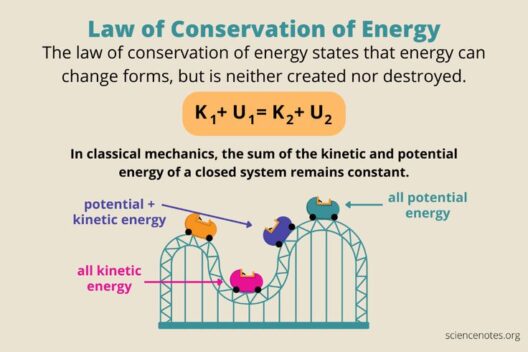Is mechanical energy always conserved in springs? This question invokes a nuanced dialogue regarding the principles of energy conservation and the peculiarities of mechanical systems. To unravel this enigma, we must delve into the fundamental concepts of mechanical energy, the characteristics of springs, and the conditions under which energy conservation holds true.
Mechanical energy is the sum of potential and kinetic energy within a system. When considering springs, we primarily contend with elastic potential energy, which is stored when a spring is compressed or extended. According to Hooke’s Law, the force exerted by a spring is proportional to its displacement from the equilibrium position. The equation governing this relationship is F = -kx, where F represents the force, k symbolizes the spring constant, and x denotes the displacement.
When a spring is neither compressed nor stretched, all the energy within the system is kinetic. As the spring is manipulated—compressed or elongated—potential energy accumulates. This stored energy can be released, converting back into kinetic energy as the spring returns to its equilibrium position. The crux of the matter is whether this mechanical energy can be considered conserved throughout the cyclic process.
To better understand this, consider a playful hypothetical scenario: What if you was to drop a spring? Upon release from a certain height, the spring not only compresses but also experiences deformation and, inevitably, dissipation of energy due to air resistance and internal frictional forces. This prompts a pivotal question—can we still declare mechanical energy conserved in such a context?
The idealized model of energy conservation presupposes that no external forces act upon the system, and that springs perfectly obey Hooke’s Law—an ideal case that rarely exists in reality. In practice, energy transformations within systems often encounter dissipation. Real springs possess mass, and when we subject them to dynamic loading, some energy is invariably transformed into other forms, such as thermal energy due to internal friction or sound energy—most notably during abrupt or oscillatory movements.
Another aspect to consider is hysteresis—a phenomenon observed particularly in materials that do not exhibit perfectly elastic properties. When a spring is stretched and then released, the path of energy dissipation does not perfectly retrace its origin during loading and unloading phases, thereby indicating that some portion of mechanical energy is irretrievably lost. Thus, while mechanical energy may seem conserved during specific segments of the oscillatory cycle, complete conservation does not hold across time due to these energy losses.
This foundational understanding raises additional inquiries. What about the energy losses associated with wear and aging? Over time, springs may lose their elasticity, and such physical degradation can further contribute to energy dissipation—not purely during active deformation, but fundamentally altering the energy dynamics within the system. As elastic potential energy is irreversibly lost, the efficiency of the spring diminishes and compromises its effectiveness.
In contrast, when springs are operated under ideal conditions—such as in controlled environments where factors like friction and air resistance are negligible—the conservation of mechanical energy can be approximated more closely. In these scenarios, the energy stored in the spring, when released, ideally converts entirely back into kinetic energy, allowing for a reasonable assumption of energy conservation within the parameters of the idealized model.
Furthermore, let’s explore systems where multiple springs interact. In complex mechanical systems—such as those found in automotive suspension or industrial machinery—the interactions between springs can lead to intricate energy exchanges. In these cases, conservation principles must be assessed with respect to cumulative system behavior rather than individual components. This convolutes the scenario, raising the complexity of energy balancing significantly.
Environmental implications also warrant consideration. In applications where springs facilitate energy storage—such as in certain renewable energy systems—inefficiencies in mechanical energy conversion can thwart potential gains in energy efficiency. To mitigate these challenges, engineers often innovate with materials and designs aimed at enhancing energy retention while minimizing loss, contributing to sustainable practices in energy consumption.
In summation, while the notion of conserving mechanical energy within springs holds merit under idealized circumstances, reality dictates a more complex narrative punctuated by losses. The phenomenon of energy dissipation, whether via thermal dissipation, hysteresis, or mechanical degradation, underscores the necessity for careful consideration of context in mechanical energy conversations. As we engineer systems with springs, the key lies in utilizing this foundational knowledge to innovate toward better energy retention and conservation practices, ultimately bolstering our efforts for sustainability in an energy-conscious world.
Thus, the playful question posed initially reveals an intricate web of scientific principles, practical realities, and environmental considerations, serving to illuminate the complexity of mechanical energy and its conservation within the realm of springs.








